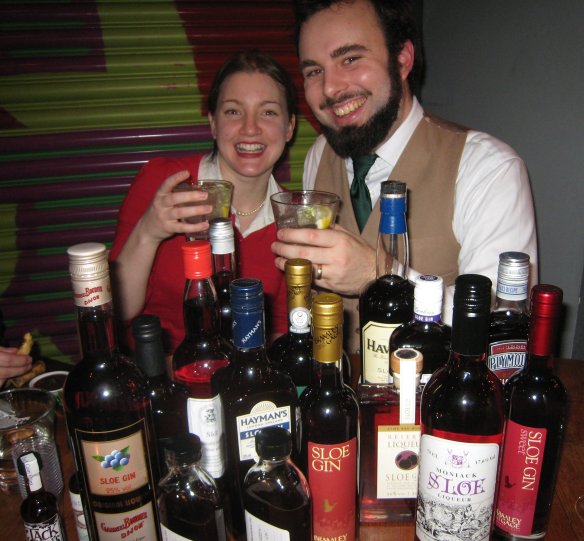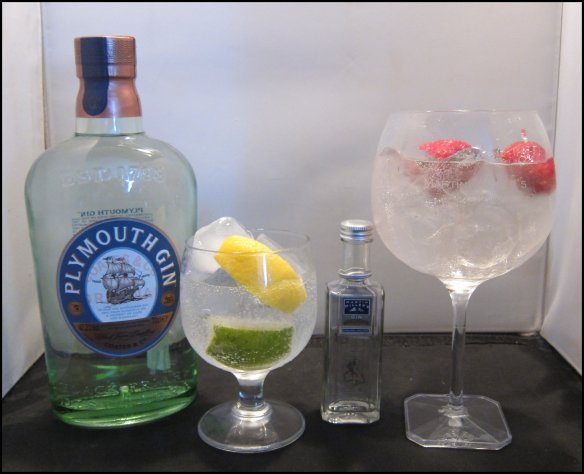Sloe Gin Tasting
A few weeks ago, a friend and colleague of mine said, “I’d quite like to do a sloe gin tasting”. Needless to say, I agreed that it was a superb idea and we immediately set about procuring various samples for the evening. Originally I thought we’d get about 8, then 12 looked for likely but, in the end, we tried 17.

L-R: Will, Hartley, Fleur, CB, DBS, Robert, Mrs. B.
We initially tried the sloe gins on their own at room temperature and then tried them mixed with Fevertree Lemon Tonic/Bitter Lemon and Fevertree Lemonade in Long Pedlers. Here follows a summary of our panel’s notes on each.
#1 Moniack Sloe Gin Liqueur (17.6% ABV)
Produced by Highland Wineries, near Inverness, this has the lowest alcoholic strength of all those that we tasted. Moniack Castle also make a selection of other liqueurs, country wines and preserves.
Nose: Cider, Rosé wine or Rose Cider (something like Jacques Cider).
Taste: Sweet, somewhat reminiscent of a White Zinfandel, with hints of rose petals and strawberries. This was rather refreshing, smooth and quite unusual, as sloe gins go, but it was agreed that it was still quite a nice drink.
Moniack Castle Sloe gin Liqueur is available for around £13 for 75cl from DrinkOn.
#2 Bramley & Gage Sweet Sloe Gin (26% ABV)
This was the first of three sloe gins that we tried from Bramley & Gage, who are well-known for their range of liqueurs, as well as their new gin and its companion tonic: 6 o’Clock.
Both Bramley’s original and sweet sloe gins use a mixture of wild Dartmoor and imported sloes, steeped in gin that Bramley make themselves. This product contain a liberal amount of sugar and was designed for people that found the original too tart.
Nose: Liquorice, almonds, cherry and marzipan.
Taste: This was very sweet; too sweet, for some (it’s worth noting that these differences are why Bramley introduced the product in the first place). It has a little acidity at end and some herbal notes.
We found that this mixed really well and was well liked by the panel.
Bramley & Gage’s Sweet Sloe Gin is available form their website for around £14 (35cl).
#3 Plymouth Sloe Gin (26% ABV)
Made using the famous Plymouth Gin and Polish sloes, this contains noticeably less sugar than its counterparts in the tasting.
I really like this; it had a great jamminess in the mouth, which the panel enjoyed, but still had a tart finish. It was found to taste less artificial than some of the others and, with the fruitiness and a little spice, there were a lot of people who thought this “smelt like Christmas”. In addition to this festive fragrance, it smells like sloe and it tastes like sloe. It was agreed that this was a first-class example of sloe gin and something of a benchmark for the others.
Along with Juniper Green this was the Most Sippable Sloe Gin.
Plymouth Sloe Gin is available for around £18 (70cl) from The Whisky Exchange and from their excellent distillery shop in Plymouth. (One of the few places in the country where you can still buy their splendid Fruit Cup).
#4 Sipsmith Sloe Gin (2009) (29% ABV)
This is the most recent release (it’s been around for about a month) from Sipsmith Distillery, who were recently voted “Best Newcomer” at the recent Observer Food Monthly Awards. It uses Sipsmith Gin as its base.
Nose: Juniper nose mixed with sloes, memories of home-made sloe gin.
Taste: This was found to be the closest to the “home-made” varieties people had tried; “just like mamma used to make”. This had a jamminess, similar to Plymouth, and the underlying Gin element was more dominant the the others. The one downside was a little sharpness at the end. Nonetheless, it was considered a great winter warmer and probably had the most potential to work well in cocktails.
The handsomely packaged Sipsmith sloe Gin is vaialable for around £17 (50cl) from The Whisky Exchange.

With our selection of Sloe Gin in the foreground Mrs. B & I enjoy a Gin & Tonic, “Evans” style.
#5 Bramley & Gage Original Sloe Gin (26% ABV)
This is a version of #2; similar, with a lower sugar content. Bramley also make a drink called Slider, which is usually made by removing the sloes from the sloe gin after maceration and combining them with cider. I used the same technique with some mincemeat vodka I made recently, making a mincemeat cider which was very tasty.
Nose: This had a similar nose to the sweet, as you may well expect.
Taste: Fruit & almond flavours, reminiscent of cherry bakewells. This was certainly tarter than the sweet variety and I found it more to my palette. It felt very warming and was, all in all, quite popular.
Bramley & Gage’s Original Sloe Gin is available form their website for around £14 (35cl).
#6 Lyme Bay Reserve Sloe Gin (26% ABV)
Part of the Reserve Liqueur range of Lyme Bay Winery (other varieties include Elderflower & Lemon and Blueberry) Lyme Bay also make a range of other country wines and liqueurs. Lyme Bay typically use English Sloes they also make a sloe wine and a Sloe wine-based fortified liqueur. I have been to their on-site shop which has good range of tasty products on offer, well worth a visit if you’re in the area. Each bottle is numbered and our was RL22676.
Nose: Smells like gin; very strong smell of juniper – a nice change.
Taste: This was sweet and smooth, and unusually light for a sloe gin. It was rather lovely and sufficiently quaff-able. All in all, it was popular with the panel, although one member remarked that it as rather Calpol (children’s medicine), but I think was actually a good thing!
Lyme Bay Sloe Gin (£11.99 for 35cl) and other products are avaialble from their website and the gift section of John Lewis.
#7 Gordon’s Sloe Gin (26% ABV)
The best-selling sloe gin in the UK with the widest distribution, too. If you’ve had commercial sloe gin, it would probably have been this. The modern version uses wild sloes, whereas its predecessor used dry sloes.
Nose: Floral and perfumed, with juniper and a bit of spice.
Taste: This was one of the few sloe gins in our tasting that people had any preconceptions of, but everyone was pleasantly surprised: everyone quite enjoyed its simple, balanced fruitiness and its intriguing notes of earl grey tea.
This was found to be The Best Mixing Sloe Gin
Gordon’s Sloe Gin is available for around £14 (70cl) from Waitrose, Tesco and other leading supermarkets.
#8 Hawker’s Sloe Gin (28% ABV)
This sloe gin has a Royal warrant (the warrant itself is held on behalf of Hawker’s by none other than Desmond Payne, Master Distiller of Beefeater) and is made with Dartmoor sloes. It is bottled at 28%; a little stronger than the usual 26%.
Nose: Geranium & mincemeat.
Taste: This was unlike anything else that we tasted that night, and it was really popular. It was quite sweet, but the panel still thought that its flavours worked. There were hints of mince pies and some strong herbal, almost menthol, notes. This is more complex than your classic sloe gin and is slightly set apart in terms of style. Although it wasn’t unanimous, this was one of the panel’s favourites.
Along with Jack Cain’s this was The Most Unusual Sloe Gin – i.e. the least like the others we had tried.
Hawker’s Sloe Gin is available for around £18 (70cl) from The Drinkshop.

- Speed-tasting with Mr. Hartley using the SCH method.
#9 Juniper Green Organic Sloe Gin (26% ABV)
We were sent some samples from October 2010 (ever so fresh then). The sloes for this sloe gin come from Romania, as it is difficult to get certified organic sloes from the UK (ensuring they have been affected by wind-drift from the crop-sprayer or fertiliser run-off from fields is tricky). The sloes are steeped in Juniper Green Gin (40%) and the sloes are left to macerate until the alcohol level of the liquid drops to 26% (as the sloes absorb the alcohol).
Nose: Clean nose, with fruit and a little cinnamon-like spice, followed by juniper berries.
Taste: A nicely balanced, home-made taste. Warming, with a light sweetness and flavours of apples, pears and cinnamon. The panel really enjoyed this and it was amongst their favourites.
Along with Plymouth this was the Most Sippable Sloe Gin.
Juniper Green Organic Sloe Gin is available for around £22 (70cl) from
#10) Hayman’s Sloe Gin (26% ABV)
This is made by family firm Hayman’s Gin this uses wild English Sloes and their own Gin as it’s base. Hayman’s also make a London Dry Gin, an Old Tom Gin and a Gin Liqueur.
Nose: lovely heavy sloe nose.
Taste: Quite light and refreshing, simple yet satisfying with a little cinnamon and a little citrus on the finish. Sweetness and tartness well balanced.
Hayman’s Sloe Gin is available for around £18 from the Whisky Exchange.
#11) Bramley & Gage Organic Sloe Gin (26% ABV)
This variety of Bramley & Gage’s sloe gin has a different spirit base and all of the sloes are imported (once again, the problem of getting certified organic sloes in the UK arises).
Nose: Strong smell of almond and marzipan, but with a more subtle scent then the other two. I believe that the almond comes from the stones of the Sloes.
Taste: This was a soft, light sloe gin, with an excellent balance of tartness and sweetness. It’s quite fruity, with some folks tasting raisins, and there was a very light saltiness at the tip of the finish. This is a great sloe gin and our clear favourite of the three Bramley & Gage’s.
Bramley & Gage’s Organic Sloe Gin is available form their website for around £17 (35cl).
#12) SLOEMotion Sloe Gin (26% ABV)
Founded in 2002 SLOEMotion now make a variety of Sloe based products: Sloe Vodka, Sloe Whisky, Sloe Brandy and of course Sloe Gin. Their sloes come from local hedgerows and they use the sloes from the liqueur making process in a range of truffles and chutneys.
Nose: Smells like bitter cherries and a little maraschino.
Taste: Juicy and tart, with a nice sweetness, a bit of caramel and a vanilla finish.
SLOEMotion Sloe Gin is available from £15.95 (35cl) from their website. I can also strongly recommend their Sloe Whisky.

Robert seems reluctant to try Mr. Harltey’s concoction a mix of 17 different sloe gins, a tasting in glass!
#13) Gabriel Boudier Sloe Gin (25% ABV)
This hot-footed to us all the way from France and is part of a range of products developed by Gabriel Boudier specifically for bartenders as opposed to a product sold in it’s own right.
Nose: Slightly reminiscent of cherry brandy and bitter almonds with a little citrus.
Taste: A good sloe gin, being both smooth and balanced with a silky texture. It was very drinkable and described as a “polite” sloe gin: delicate, but tasty and reminding one panel member of a “lovely big pillow”.
Gabriel Boudier Sloe Gin is available for around £17 (70cl) from The Drinkshop.
#14) Marks & Spencer’s Sloe Gin (26% ABV)
Marks & Spencers have a good range of own brand wine & spirits in addition to the sloe gin they make a Pink Gin and a Gin Fizz. Their sloe gin in made in France and contains: juniper, coriander, lemon & orange peel, angelica, orris root and fennel seeds. The bottle recommends serving it on-the-rocks or with tonic.
Nose: Sweet, with hints of almond and marzipan, a little cherry brandy.
Taste: A very short flavour, but easy to drink, with a pleasant smoothness. Although this sloe gin had no really remarkable qualities, we all agreed that this had wide appeal. This was surprisingly similar to number 13.
Marks and Spencer Sloe Gin is available for £10.99 (50cl) from larger M&S stores.
#15) Foxdenton Sloe Gin (29% ABV)
This is made by Foxdenton Estate, who also produce an excellent 48% gin (review here) as well as a range of other liqueurs. This was paler than most sloe gins, and was bottled at slightly stronger 29%.
Nose: Strong gin spirit, followed by a little sweetness and then the fruitiness of the sloe.
Taste: This was the least thick & sticky of our sloe gins. Initially, you can really taste the underlying gin, foillowed by the sweetness and the sloes. This is neither sweet, nor excessively sharp; it is both different and tasty and, for that reason alone, is really worth trying.
Foxdenton Sloe Gin is available for £18.80 (70cl) from their website along with their other liqueurs. Smaller sizes of the Sloe Gin are available.
#16) Cowen Sloe Gin (26% ABV)
From Malcolm Cowen (Drinks) Ltd., this sloe gin is bottled at 26%. The gin is distilled at Thames Distiller and they use organic sloes. Cowen also make and distribute a variety of other hard-to-find liqueurs.
Nose: Sweet cherries, followed by the underlying gin spirit and a hint of dry almonds.
Taste: This sloe gin fills the mouth with the flavour of sweet ripe berries and a little lavender. This fades to some dryness and a warming finish. A nice example of sloe gin.
Cowen is available for around £16 (50cl) from The Drinkshop.
#17) Jack Cain’s Sloe Gin (30% ABV)
At 30% ABV, Jack Cain’s Sloe Gin was the strongest of the bunch and opinion was split on it, but those who liked it, loved it. One such fan noted:
Nose: “The nose was really sweet and richly floral with notes of violets.”
Taste: “I was expecting sickly sweet, but I was very much mistaken; instead it was sharp and dry with a little chocolate and citrus. This is really very different with the dryness of an aged rum, a very nice experience.”
Along with Hawkers this was The Most Unusual Sloe Gin
Jack Cain’s Sloe Gin is available from a variety of locations.
It is always difficult to come up with ranking system to do the tasting justice when you have so many varieties and quite a large panel; but we did come up with a panel top 5 so in no particular order:
Plymouth Sloe Gin
Bramley Organic Sloe Gin
Foxdenton Sloe Gin
Hawker’s Sloe Gin
Juniper Green Organic Sloe Gin
It is worth noting that to be considered “sloe gin” a spirit must be of a minimum strength of 25%ABV. I imagine that this along with being a sweet spot for taste is why most Sloe Gins are bottled at around this strength. (Thanks to Michael for this update).
For details on which sloe gins worked well when mixed, please see: The Sloe Peddler.
I would like to thank the folks at Graphic Bar for hosting the event, the producers who have been very generous at sending us samples of their Sloe Gins, Fevertree for providing the mixers and of course the panel.
Keep In touch
Summer Fruit Cup’s Facebook
Summer Fruit Cup Twitter























